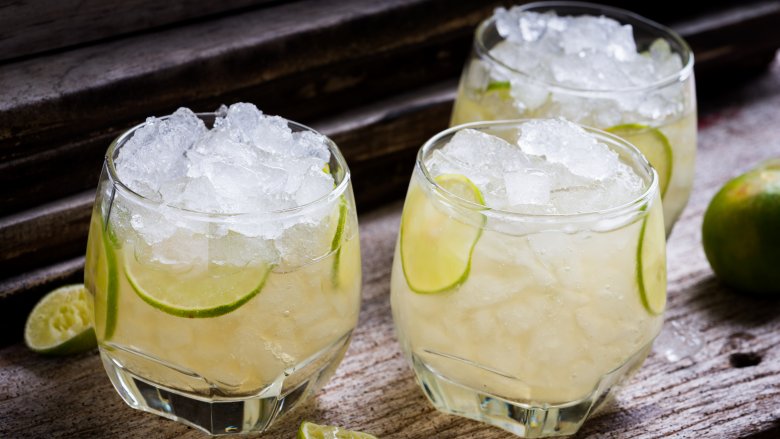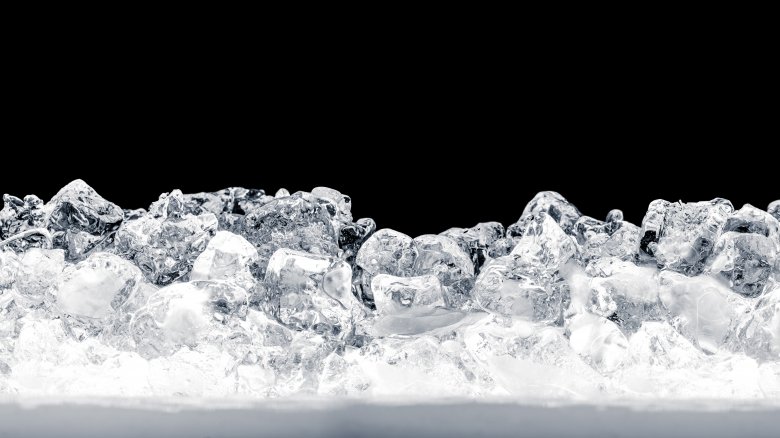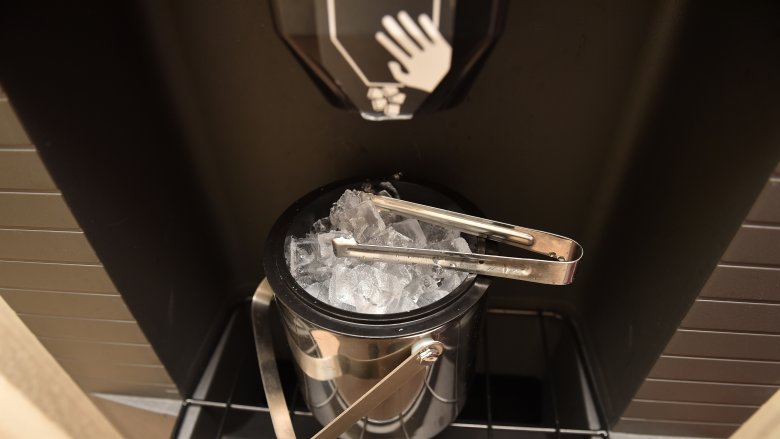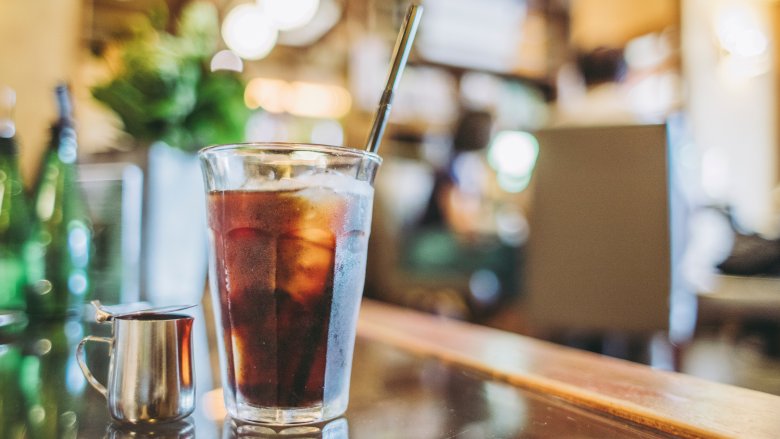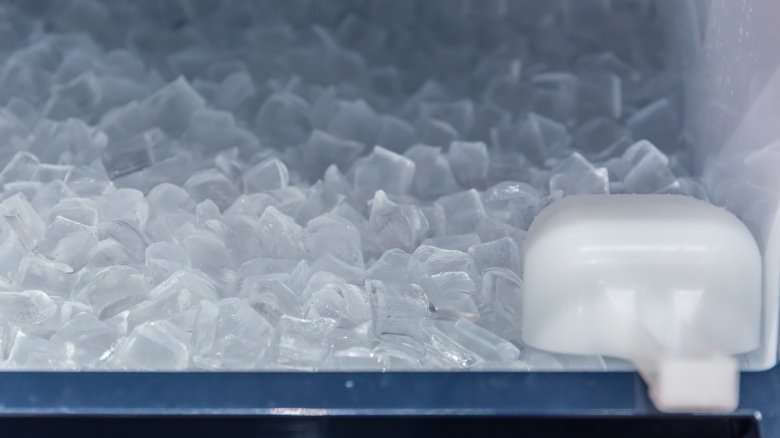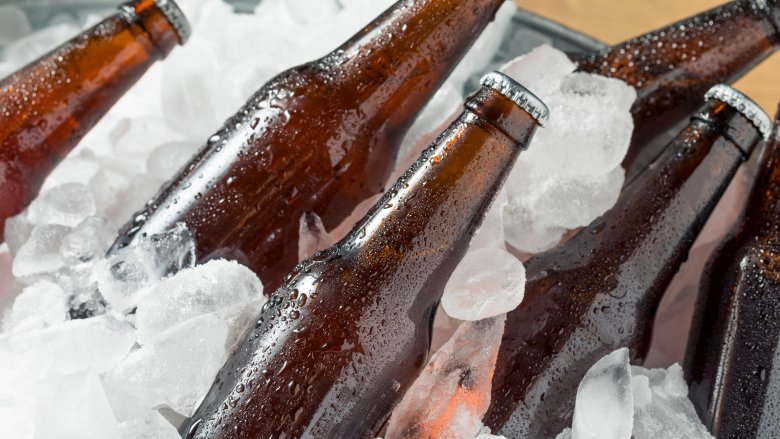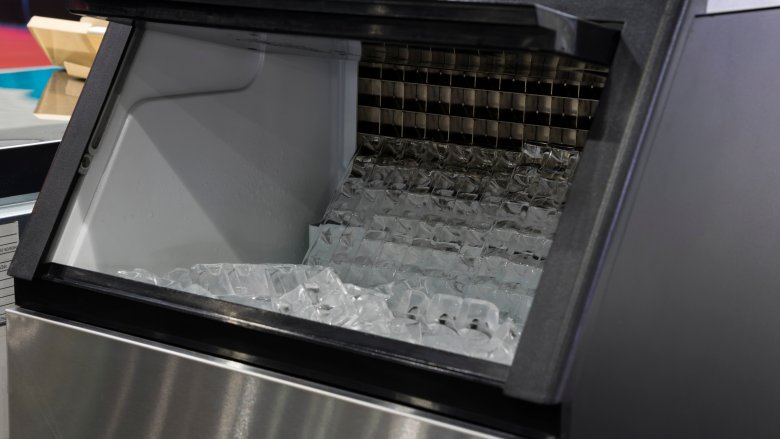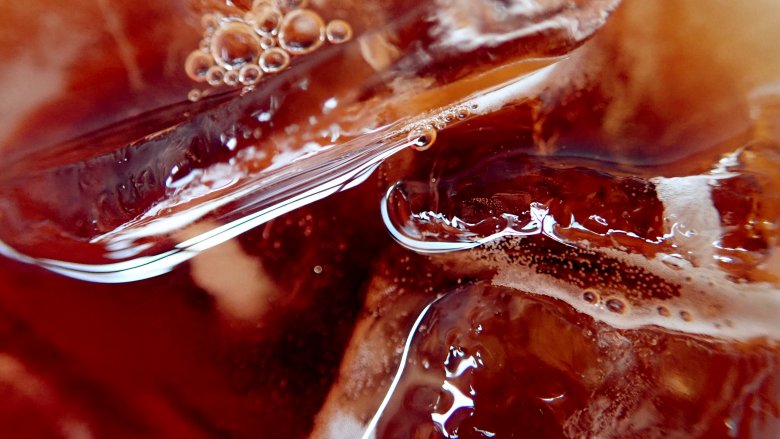Here's Why You Should Never Get Ice In Your Drink
If you head out to a bar or restaurant, there's a good chance you're not only getting a cocktail, a soda, or a strawberry lemonade, but you're also getting ice. You've done it hundreds, if not thousands, of times, right?
You should probably stop.
Get the drinks, sure, but when it comes to going out and picking up an iced tea, iced coffee, or anything else with ice, you'd be better off skipping that part entirely. And there's not just one reason for that, there are a whole bunch of reasons.
We'll start with the fact that if you've ever gone out for drinks and then felt a little funky afterwards, that may have been because you had some ice contaminated with foreign bodies. There's a surprising number of things that can go wrong with ice, starting with the oh-so-common presence of fecal bacteria and getting no better from there. Here's why you should skip the ice and opt for something a little less dangerous.
There's a lot of poop bacteria in there
No one wants to even think about the word "fecal" at the same time they're thinking about their food, but when it comes to ice, well, you have to go there.
In 2017, BBC released the results of an investigation into three major coffee chains: Starbucks, Costa, and Caffè Nero (via The Guardian). When they tested their iced water, they found that some samples from every chain contained coliform bacteria, which is, essentially, poop bacteria. 30 percent of both Starbucks and Caffè Nero's samples were contaminated, while Costa had a whopping 70 percent of their iced water come back, well, poopy.
Experts said definitely a reason to be concerned, and foodborne pathogen expert Rob Kingsley from Quadram Institute Bioscience put it this way: "I would certainly think twice about eating something which may contain fecal contamination at that level, where it is detectable."
It's not just at coffee chains, either. Another BBC study (via Business Insider) found similar levels of contamination in the ice at KFC, McDonald's, and Burger King. You might never be able to un-know that... and maybe that's a good thing.
There's probably mold in the ice machine
NewAir says there's a popular misconception about ice machines that makes them particularly dangerous, and that's the widespread belief that since they're so cold, bacteria and mold won't grow. In fact, they can actually be a breeding ground for mold.
According to QBR Refrigeration (via Click2Houston), they see moldy, slimy ice machines way more often than any restaurant customer would ever want to think about. Part of their job is giving those machines a good cleaning, and they say that by the time they get there, they're usually filled with black, greasy slime, or pink, moldy sludge. Yum?
The most commonly disgusting place, they say, is the ice cavity at the chute. Yes, that's where the ice comes out and plops into your drink, and that means every drink served can be contaminated with ice that's been run through a moldy machine. That mold is essentially a vehicle for the bacteria that can make people very sick, and experts say that while having a dirty ice machine is a serious health code violation, they're also notoriously hard to clean and not frequently inspected.
The FDA only has so much control
Since this is a food-related issue, you'd think the FDA would be involved in implementing all the rules and regulations needed to make sure ice is safe. But here's the thing: The FDA does regulate packaged ice — the sort you pick up at the store for your cooler — and they have guidelines in place that specify everything from what kind of water can be used to the hygiene policies employees need to follow.
There's a huge "but" here: They don't regulate or inspect the ice made by bars, restaurants, and other food service establishments.
And that's weird. According to Food Safety Magazine, articles about the presence of fecal bacteria in ice were published in the Journal of the American Medical Association as far back as the 1950s. It's taken the FDA and the CDC decades to catch up on any kind of regulation, and even into the 21st century, FDA regulations on the cleaning of ice-making equipment in the food industry simply states that machines need to be cleaned "at a frequency specified by the manufacturer," which tends to be between two and four times a year. Would you be okay with those same regulations being applied to, say, the stovetop used to cook your food?
There are tons of ways nastiness gets in there
Ice machines are sneaky, says NewAir, and there's a ton of ways a bin can become contaminated with nastiness and bacteria. Some aren't even very obvious — machines have a tendency to accumulate dust and even yeast present in the air.
If water isn't drained often and completely replaced, it's super easy for sludgy slime to start building up. Ice machines have all kinds of nooks and crannies that are difficult to clean, and here's a question: Have you ever seen employees dumping fresh ice into a cooler or a soda machine? How long do you think they've been doing that without completely emptying and cleaning that machine? It's a recipe for disaster.
Food Safety Magazine adds that poor food handling and sanitation practices is one of the most common ways ice gets contaminated, and that includes being touched by employees not properly washing their hands. According to a study by Michigan State University, only about 5.3 percent of nearly 4,000 people observed washed their hands for the recommended 15 seconds or more.
Even a whopping dose of booze won't kill most bacteria
You've probably seen those old-timey movies where alcohol is used as an antiseptic, but here's the thing: It's not going to work on the bacteria in and on the ice in your drink. Science says so.
A study from the Annals of Microbiology looked at this precise thing. They started by taking 60 samples of ice cubes from a variety of sources, including private homes, commercial food service, and industrial settings. They were able to isolate 52 different strains of bacteria, and then tested them with various liquors and mixers to see if any where capable of killing any of the bacteria present.
Results were mixed. Many microorganisms survive a bath in mixers like peach tea, Coke, and tonic water, and some even survived vodka (via the American Council on Science and Health). The only liquid that was able to kill all the bacteria was whiskey. Order any other cocktail and you're going to be getting more in your drink than you bargained for — and it definitely wasn't on the menu.
People don't think of ice in the same way as food
In 2006, NBC News reported on a heartbreaking story that involved a healthy 15-year-old boy who played a round of golf at a tournament and was dead the next morning. The cause of death was norovirus, and the source was the ice in a cooler of drinking water given to the golfers. Dozens of people got sick, and health officials said the root cause was most likely an employee who hadn't washed their hands before handling the ice. NBC spoke with microbiologist Debra Huffman from the University of South Florida, and found there's a few reasons why contaminated ice is a huge problem.
Huffman says that there's no smell to contamination, and you can't see it — so the people who are carrying it don't know they're depositing dangerous microorganisms into ice. Also, ice in restaurants is often handled by employees that aren't cooks — think drive-thru staff filling to-go cups after taking money from drivers. There's also a tendency for staff not to think of ice as food, and be less strict when it comes to hygiene practices than they would be about standard food — and it's an oversight that can be downright deadly.
Fast food employees even skip it
How about some testimony right from the horse's mouth? When one Redditor asked, "Fast food workers of Reddit, what should we NOT order at your restaurant? Why not?", this was one response:
"I've worked at 4 restaurants in my life and lemons and ice are by far the most disgusting things you can get."
When commenters asked for clarification, another Redditor volunteered this: "Usually because no restaurant ever has cleaned out the ice machine. ... If you got people with dirty hands with a scoop, scooping out ice, you can imagine all the nasty particles that rub off on ice."
Numerous people spoke up with their experiences of employees who rarely, if ever, cleaned the ice machines, and one added a particularly disturbing trend they had witnessed: Employees who used glasses to scoop out ice, and those glasses would occasionally chip in the cooler. There's a reason people aren't supposed to do that, but then again, there are a lot of things that people just aren't supposed to do, and yet they keep on doing them. So play it safe — skip the ice.
Those microorganisms are going to survive
When we start talking about the bacteria and viruses that are carried by ice and have the potential to cause food poisoning, we're not just talking about the kind that's introduced after someone makes a trip to the bathroom and then doesn't wash their hands. Food Safety Magazine says we're also talking about things like Salmonella, E. coli, hepatitis A, and norovirus.
They're all a big deal. Norovirus has been called "the most infectious agent ever studied in humans," and that's pretty terrifying stuff for a few different reasons. The freezing cold temperatures found in ice machines aren't going to kill bacteria or viruses, and it's not going to make them inactive, either. Microorganisms — like norovirus — can survive quite happily in freezing temperatures and inside ice cubes, and it doesn't take a lot to make someone seriously ill. Only a few particles can do some serious damage, so you can imagine that it doesn't take much for an ice machine or cooler contaminated by a single person to cause an outbreak.
